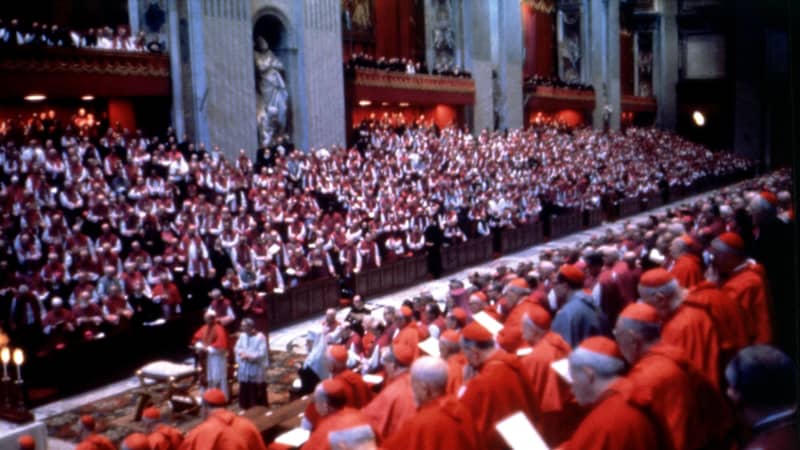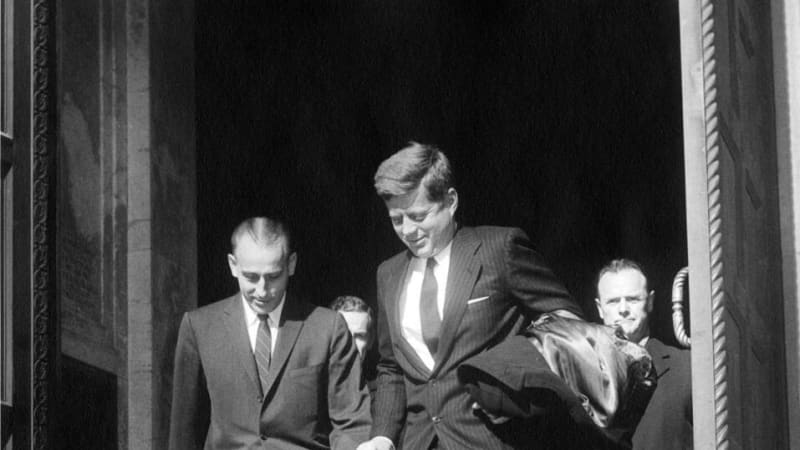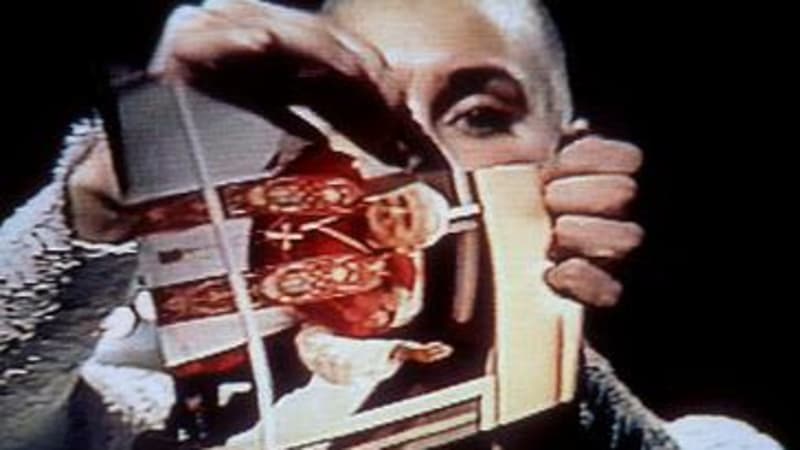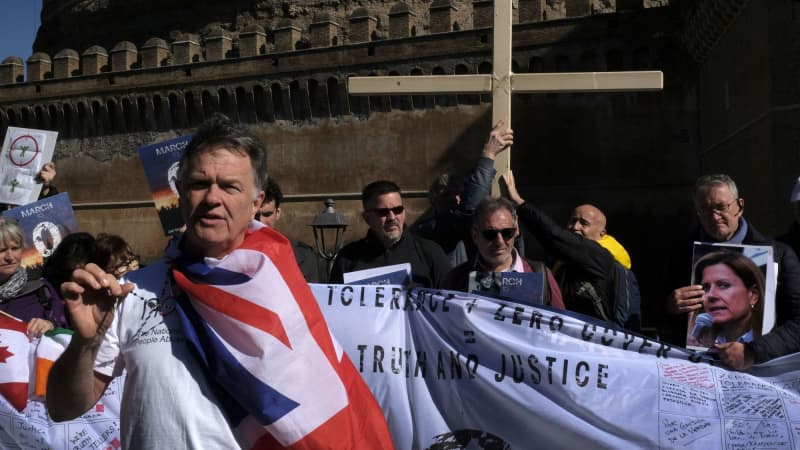Content warning: This article discusses sexual assault.
A play is always in conversation with three eras: when it was written, when its story is set, and whenever it is performed. John Patrick Shanley’s Doubt: A Parable was written in 2004, set in 1964, and is now being revived by Roundabout in 2024. The play centers around a nun in a Bronx Catholic school, Sister Aloysius Beauvier, accusing a priest, Father Brendan Flynn, of sexually abusing a schoolboy. Public perception regarding the issue of sexual abuse in the Catholic Church has changed considerably over the years, and these changes have greatly informed how the play was written and how it has been perceived.

Pope Paul VI attends mass during a session of the Second Vatican Council.

President John F. Kennedy (right) and Dr. Charles A. Hufnagel exit the Cathedral of Saint Matthew the Apostle in Washington, DC after attending mass on January 29, 1961.
Doubt: A Parable takes place in a pivotal time of change for the Catholic Church in America: 1964. In November 1964, Pope Paul VI introduced the “New Mass,” one of many reforms introduced by the Second Vatican Council, also known as Vatican II: a summit intended to bring the Catholic Church into the 20th century. The New Mass was a revolutionary update of Catholic Sunday services, which involved ordinary parishioners in the liturgy to a greater degree, and, in America, set the Mass in English, as opposed to Latin, which had been the traditional norm for centuries. These changes were intended to make church services more comprehensible and accessible to the faithful, although it was met with opposition from traditionalists accustomed to the old ways of worshiping.
Only a year before, in 1963, John F. Kennedy, the first Catholic President of the United States, had been assassinated. During the campaign season that led to his election, some of Kennedy’s opponents implied that a Catholic president would have to take orders from the Pope rather than the American people. In response, Kennedy downplayed his Catholicism, famously saying, “I am not the Catholic candidate for president. I am the Democratic Party’s candidate for president, who happens also to be Catholic. I do not speak for my church on public matters, and the church does not speak for me.” This history-making election, along with the changes introduced by Vatican II, signified that Catholics were becoming more integrated into the American mainstream, after centuries of discrimination.
Around this time, John Patrick Shanley was attending St. Anthony’s Grammar School in the Bronx. By his own admission, he was mischievous and argumentative in response to the restrictive atmosphere at the school – however, he respected the nuns, and later drew inspiration from a nun named Sister James, giving her name to a character in Doubt: A Parable.
2004
Doubt: A Parable premiered in 2004, 40 years after Vatican II and Shanley’s Catholic school days. While Shanley has stated that the play was inspired by “courtroom culture” in America – as well as the Iraq War, and President George W. Bush’s unwavering belief in the existence of Iraqi weapons of mass destruction – it is undeniable that the play was also inspired by contemporaneous events that were shaking the Catholic Church across the globe.
In February 2002, a Boston priest named John Geoghan was tried and convicted of sexually abusing children in the parishes where he worked. Geoghan was accused of over 130 instances of sexual abuse, ranging from 1962, when he was ordained in the clergy, to 1998, when he was finally defrocked, or removed from the clergy. Among his accusers was a relative of John Patrick Shanley’s.
The Boston Globe reported on the Geoghan case and its trial, kicking off an intensive investigation into sexual abuse in the Boston Catholic Church. A team of journalists found that Cardinal Francis Bernard Law of the Boston archdiocese had systematically worked to cover up sexual assaults in his archdiocese, moving priests from one parish to another when allegations were raised (a practice known as “priest shuffling”). The Globe’s team was awarded a Pulitzer for their efforts to bring this issue to light.
In April 2002, as more and more sexual assaults were being brought to light, Pope John Paul II spoke out against the issue for the first time. While he did not address specific cases in America, it was a public statement that would have been unthinkable only a decade prior. In 1993, Irish singer Sinéad O’Connor had sought to bring attention to this issue on an episode of Saturday Night Live. After singing a cover of Bob Marley’s “War,” with lyrics changed to mention child abuse, O’Connor tore up a photo of Pope John Paul II, looked into the camera, told the audience to “Fight the real enemy,” and walked offstage. At that time, the incident led to public backlash against O’Connor, who was denounced and mocked by various celebrities, religious organizations, and church authorities, while her records were destroyed outside of NBC’s studios. O’Connor later wrote an open letter explaining that she had suffered abuse growing up in the Catholic Church, and she wished to use her voice to raise awareness about this issue. Although her protest had a major impact on her public image, O’Connor never regretted it; years later, she wrote, “A lot of people say or think that tearing up the pope’s photo derailed my career. That’s not how I feel about it. I feel that having a number-one record derailed my career and my tearing the photo put me back on the right track.”

Sinéad O’Connor rips up a photo of Pope John Paul II during a performance on Saturday Night Life in 1993.
2024
Twenty years later, popular understanding of the issues Doubt: A Parable wrestles with has become gradually more nuanced. The work of the Boston Globe’s journalists to uncover abuse in the Boston Catholic Church was dramatized in the 2015 film Spotlight, which won the Oscar for Best Picture – and also earned a positive review from Vatican Radio, the official radio station of Vatican City. In 2017, reporters from The New York Times and The New Yorker released extensive reports on film producer Harvey Weinstein’s history of sexual harassment and assault. This reportage led to a wave of further consequences for public figures accused of abusing their power and privilege, bringing a stronger mainstream focus on the issues of sexual assault and its impacts.

Victims and members of the global organization Ending Clergy Abuse (ECA) take part in a global 'March to zero' for the victims of sex abuse, on February 23, 2019, in Rome, Italy, during the Meeting on the Protection of Minors in the Church.
In 2019, Pope Francis convened the Meeting on the Protection of Minors in the Church – an unprecedented Vatican summit on preventing sexual abuse by members of the clergy. The summit had arguably been prompted by negative reactions to remarks he had made a year before: in defense of a Chilean bishop accused of protecting a priest who had been found guilty by the Vatican of sexual abuse, Francis said “There is not one single piece of evidence. It is all slander. Is that clear?” The Pope received much criticism for these remarks; he eventually met with Chilean abuse victims to apologize in person.
The Meeting on the Protection of Minors in the Church received a wary response from many survivors’ groups, which demanded specific action instead of broad denunciations. Anne Barrett Doyle, a leading activist against abuse in the Church, pointed out that the Meeting has not led to the establishment of a zero-tolerance policy for abusers – a concrete step towards accountability. It remains to be seen how, in the future, Catholic Church authorities will handle this problem, and who they will choose to believe.
References:
|
Note: Members of the New York Public Library can access JSTOR and many other research databases through the library’s Articles & Databases page. Bonnefoy, Pascale; Ramzy, Austin. “Pope’s Defense of Chilean Bishop in Sex Abuse Scandal Causes Outrage.” The New York Times, 19 Jan. 2018. Brown, Lane. “Director John Patrick Shanley and His First-Grade Teacher on the Difference Between Doubt and The Flying Nun.” New York Magazine, 12 Jan. 2009. Buckley, Cara. “Spotlight Gets a Vatican Audience.” The New York Times, 5 Feb. 2016. Calhoun, Ada. “Bryony Lavery and John Patrick Shanley Dish About Religion.” New York Magazine, 3 Sep. 2004. Caramanica, Jon. “The Night Sinéad O’Connor Took on the Pope on ‘S.N.L.’” The New York Times, 26 July 2023. Dugan, George. “U.S. Catholics Begin Reforms in the Mass.” The New York Times, 30 Nov. 1964. Giuffrida, Angela. “Little progress since Vatican’s sexual abuse summit, say activists.” The Guardian, 17 Feb. 2020. Henneberger, Melinda. “Scandal in the Church: The Vatican; Pope Says Bishops Must Act Firmly in Cases of Abuse.” The New York Times, 21 Apr. 2002. Hochman, Steve. “Sinéad’s Defense: She Says She Seeks Truth.” LA Times, 24 Oct. 1992. Horowitz, Jason. “Pope Opens Meeting on Clerical Sex Abuse Under Great Pressure From Victims for Change.” The New York Times, 21 Feb. 2019. Mullins, Lisa. Jolicoeur, Lynn. “’I Am Not The Catholic Candidate For President’: How Faith Shaped JFK And His 1960 Campaign.” WBUR, 25 May 2017. O’Connor, Sinead. Rememberings. Sandycove, 2021. Rezendes, Michael. “Church Allowed Abuse by Priest for Years,” The Boston Globe, 6 Jan. 2002. Witchel, Alex. “The Confessions of John Patrick Shanley,” The New York Times, 7 Nov. 2004. |



